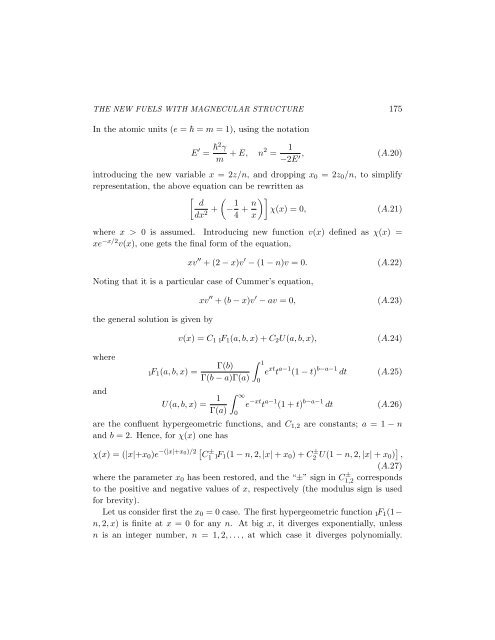the new fuels with magnecular structure - Institute for Basic Research
the new fuels with magnecular structure - Institute for Basic Research
the new fuels with magnecular structure - Institute for Basic Research
You also want an ePaper? Increase the reach of your titles
YUMPU automatically turns print PDFs into web optimized ePapers that Google loves.
THE NEW FUELS WITH MAGNECULAR STRUCTURE 175<br />
In <strong>the</strong> atomic units (e = = m = 1), using <strong>the</strong> notation<br />
E ′ = 2 γ<br />
m + E, n2 = 1<br />
−2E ′ ,<br />
(A.20)<br />
introducing <strong>the</strong> <strong>new</strong> variable x = 2z/n, and dropping x 0 = 2z 0 /n, to simplify<br />
representation, <strong>the</strong> above equation can be rewritten as<br />
[ d<br />
(−<br />
dx 2 + 1 4 + n )]<br />
χ(x) = 0,<br />
(A.21)<br />
x<br />
where x > 0 is assumed. Introducing <strong>new</strong> function v(x) defined as χ(x) =<br />
xe −x/2 v(x), one gets <strong>the</strong> final <strong>for</strong>m of <strong>the</strong> equation,<br />
xv ′′ + (2 − x)v ′ − (1 − n)v = 0.<br />
(A.22)<br />
Noting that it is a particular case of Cummer’s equation,<br />
xv ′′ + (b − x)v ′ − av = 0,<br />
(A.23)<br />
<strong>the</strong> general solution is given by<br />
v(x) = C 1 1 F 1 (a, b, x) + C 2 U(a, b, x),<br />
(A.24)<br />
where<br />
and<br />
1F 1 (a, b, x) =<br />
Γ(b)<br />
Γ(b − a)Γ(a)<br />
U(a, b, x) = 1<br />
Γ(a)<br />
∫ ∞<br />
0<br />
∫ 1<br />
0<br />
e xt t a−1 (1 − t) b−a−1 dt<br />
e −xt t a−1 (1 + t) b−a−1 dt<br />
(A.25)<br />
(A.26)<br />
are <strong>the</strong> confluent hypergeometric functions, and C 1,2 are constants; a = 1 − n<br />
and b = 2. Hence, <strong>for</strong> χ(x) one has<br />
χ(x) = (|x|+x 0 )e −(|x|+x 0)/2 [ C ± 1 1F 1 (1 − n, 2, |x| + x 0 ) + C ± 2 U(1 − n, 2, |x| + x 0) ] ,<br />
(A.27)<br />
where <strong>the</strong> parameter x 0 has been restored, and <strong>the</strong> “±” sign in C ± 1,2 corresponds<br />
to <strong>the</strong> positive and negative values of x, respectively (<strong>the</strong> modulus sign is used<br />
<strong>for</strong> brevity).<br />
Let us consider first <strong>the</strong> x 0 = 0 case. The first hypergeometric function 1 F 1 (1−<br />
n, 2, x) is finite at x = 0 <strong>for</strong> any n. At big x, it diverges exponentially, unless<br />
n is an integer number, n = 1, 2, . . . , at which case it diverges polynomially.














